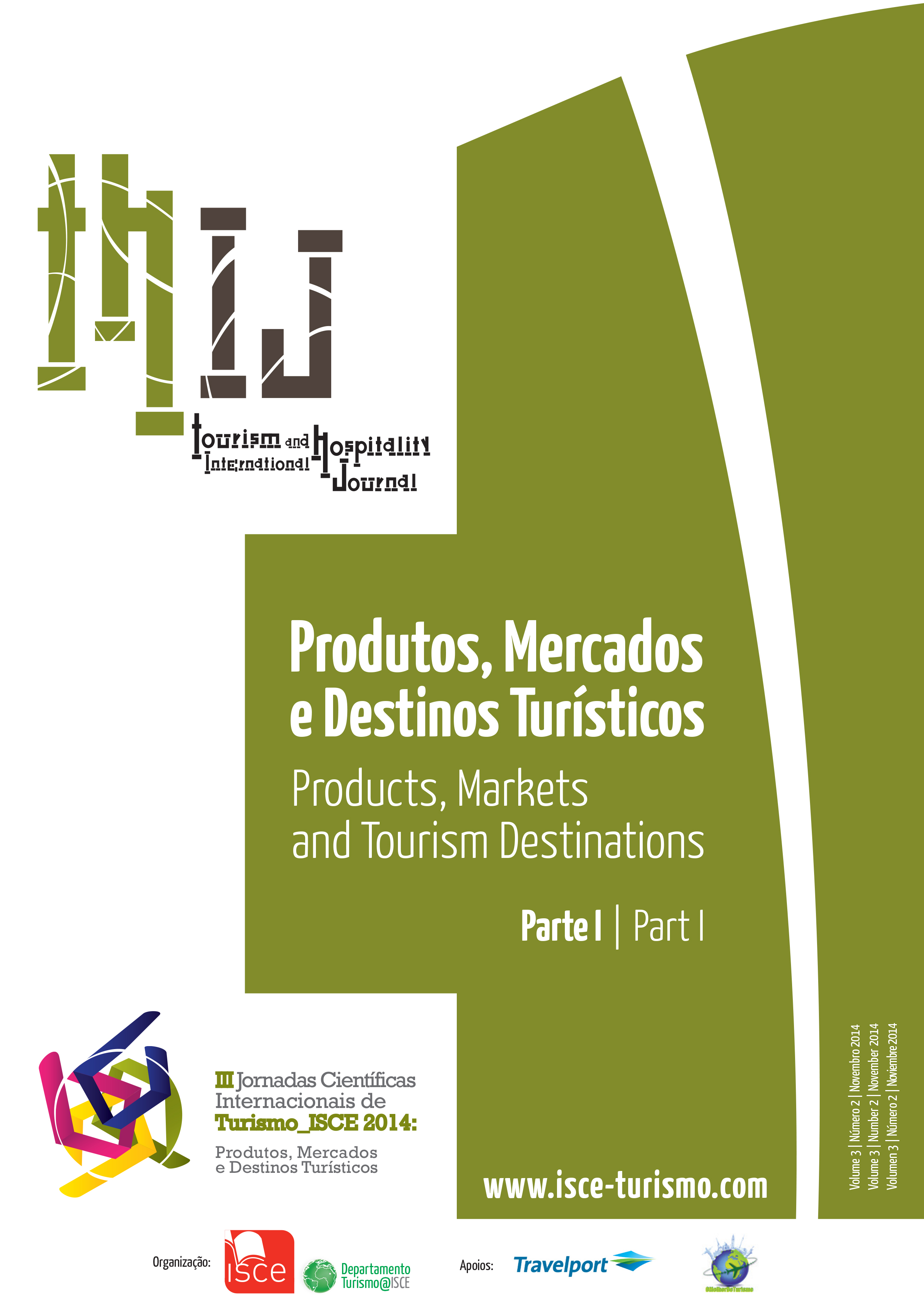The challenges of seasonality in tourism: Strategies for the valorisation of the touristic offer in Ovar
DOI:
https://doi.org/10.57883/thij3(1)2014.30140Keywords:
Seasonality, Tourism System, Ovar, Tourism segmentation, Seasonality managementAbstract
The tourism sector is currently understood as one of the economic activities that contributes most to the economic development of a destination, assuming itself as a complex and dynamic system, influenced directly and indirectly by a set of trends associated with various markets. Seasonality is a comprehensive and transversal phenomenon to several domains, including the tourism sector. Ovar is characterised by significant seasonality patterns, along with a still developing tourism activity. This research was based on a face-to-face survey of the municipality's tourist offer. Based on the results obtained it was found that Ovar is a destination that is mainly associated to the Sun and Sea tourism, revealing some gaps in terms of dissemination, in the creation of partnerships and synergies and the ability to adopt competitive strategies. As a result, there is an urgent need to invest in the creation of new products and the attraction of new market niches, in effective marketing, in the promotion of partnerships and strategies between the various stakeholders. The present text seeks to highlight the potential of Ovar destination and evaluate the performance of the tourism offer, in order to provide new lines of development capable of mitigating the seasonality phenomenon and improve the future performance of the tourism activity in the municipality.
References
Referências
Baum, T. & Hagen, L. (1999). Responses to seasonality: the experiences of peripheral destinations. International Journal of Tourism Research.
Beni, M. (1997). Análise Estrutural do Turismo. São Paulo: Editora SENAC.
Boullón, R. (1985). Planificación del espacio turístico. México: Trillas.
Butler, R. W. (1980). The concept of a tourist area cycle of evolution: implications for management of resources (Vol. 24, n. º 1). University of Western Ontario: Canadian Geographer.
Butler, R. W. (1994). Seasonality in tourism: Issues and implications. In T. Baum & J. Y. Chung (2009). Seasonality in tourism. A review. e-Review of Tourism Research (eRTR), 7,(5), 82-96. http://list.rpts.tamu. edu/ertr/
Cooper, C; Fletcher, J; Wanhill, S; Gilbert, D. & Shepherd, R. (2001). Turismo, princípios e prática. São Paulo: Editora Bookman.
Carvalho, P. & Marujo, M. (2010). Turismo, desenvolvimento e planeamento sustentável. Curitiba: Turismo & Desenvolvimento.
Fernandes, J. L. (2013). Turismo, precariedade territorial e dinâmicas de desterritorialização. In F. Cravidão & N. Santos (Eds.), Turismo e cultura. destinos e competitividade. Coimbra, IUC.
Goeldner, C. R. & Ritchie J. R. B. (2009). Tourism: Principles, practices, philosophies (11th ed.). Hoboken: John Wiley & Sons.
Gunn, C. (1989). Tourism planning fundamentals. Department of Recreation and Parks. College Station: Texas A&M University.
Gunn, C. A. & Var, T. (2002). Tourism planning: Basics, concepts, cases (4th ed.). London: Routledge.
Inskeep, E. (1991), Tourism planning: An integrated and sustainable development approach. New York: Van Nostrand Reinhold.
Instituto Nacional de Estatística [INE] (2004, 2005,2006, 2007, 2008, 2009, 2010, 2011). Anuários estatísticos regionais – Informação estatística à escala regional e municipal. Lisboa: Instituto Nacional de Estatística.
Kaspar, C. (1976). Le tourisme, objet d’étude scientifique. Tourism Review, 31(4), 2-5.
Kastenholz, E. & Almeida, A. (2008). Seasonality in rural tourism: The case of North Portugal. Tourism Review, 63(2), 5-15.
Kotler, P., Bowen, J. & Makens, J. (1996). Marketing for hospitality and tourism (5ª ed.). Pearson Prentice Hall.
Lee, C., Bergin-Seers, S., Galloway, G., O’Mahony, B. & McMurray, A. (2008). Seasonality in the tourism industry: Impacts and strategies. Australia: CRC for Sustainable Tourism Pty, Ltd.
Leiper, N. (2004). Tourism management (3.ª ed.). London: Arnold.
Mill, R. C. & Morrison, A. M. (2009). The tourism system (6.ªed.). Iowa: Kendall Hunt Publishing Company.
Murphy, P. E. (1985). Tourism: A community approach. New York: Routledge.
Organização Mundial de Turismo [OMT] (2011). Tourism towards 2030: Global overview. Madrid: World Tourism Organization.
Organização Mundial de Turismo [OMT] (2001). Apuntes de metodología de la investigación en turismo. Madrid: Organização Mundial de Turismo.
Pardal, L. & Correia E. (1995). Métodos e técnicas de investigação social. Porto: Areal Editores.
Poon, A. (1993). Tourism, technology and competitive strategies. Oxon: CAB International.
Santos, N. & Gama, A. (1999). Os espaços/ tempos de lazer na sociedade de consumo contemporânea. Revista Cadernos de Geografia, 19, 115.126.
Simões, J. & Ferreira, C. (2009). Turismos de nicho: Motivações, produtos, territórios. Lisboa: Centro de Estudos Geográficos, Universidade de Lisboa.
Wall, G. & Mathieson, A. (2006). Tourism: Changes, impacts and opportunities. Harlow: Pearson Education.
Witt, S. & Moutinho, L. (1995). Tourism marketing and management handbook. UK: Prentice Hall.
Downloads
Published
How to Cite
Issue
Section
License
Copyright (c) 2014 This work is licensed under a Creative Commons - Attribution 4.0 International (CC BY 4.0)

This work is licensed under a Creative Commons Attribution 4.0 International License.
This work is published under the Creative Commons Attribution 4.0 International License.






